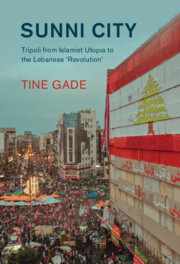Book contents
- Sunni City
- Cambridge Middle East Studies
- Sunni City
- Copyright page
- Contents
- Figures
- Acknowledgements
- Who Is Who in Tripoli?
- Timeline of Major Events
- Note on Arabic Transliteration
- Introduction
- 1 Tripoli’s City Corporatism and Identity Politics during the Nationalist Era (1920–1979)
- 2 Regional Proxy War
- 3 The Postwar Erosion of Tripoli’s City Corporatism
- 4 The Globalization of Islam and the Crisis of Religious Authority
- 5 The Future Movement
- 6 Tripoli’s Islamists
- 7 The Impact of the Syrian Civil War and Beyond (2011–2020)
- Conclusion
- Bibliography
- Index
- Books in the Series
1 - Tripoli’s City Corporatism and Identity Politics during the Nationalist Era (1920–1979)
Published online by Cambridge University Press: 10 November 2022
- Sunni City
- Cambridge Middle East Studies
- Sunni City
- Copyright page
- Contents
- Figures
- Acknowledgements
- Who Is Who in Tripoli?
- Timeline of Major Events
- Note on Arabic Transliteration
- Introduction
- 1 Tripoli’s City Corporatism and Identity Politics during the Nationalist Era (1920–1979)
- 2 Regional Proxy War
- 3 The Postwar Erosion of Tripoli’s City Corporatism
- 4 The Globalization of Islam and the Crisis of Religious Authority
- 5 The Future Movement
- 6 Tripoli’s Islamists
- 7 The Impact of the Syrian Civil War and Beyond (2011–2020)
- Conclusion
- Bibliography
- Index
- Books in the Series
Summary
How did Tripoli, a medium-sized secondary city, become the centre of Lebanon’s anti-imperialist and Arab nationalist protest movement?
Anti-French mobilizations in Tripoli created a unique city corporatism that helped to unite most of the Sunni population politically until the 1970s. When Tripoli was carved out of Syria and attached to the new state of Greater Lebanon in 1920 by the French mandate, the city lost its importance and was demoted to secondary status.
This paved the way for a strong, Arab nationalist city identity in Tripoli, driven by Abdulhamid Karami, a man of religion turned politician. Tripoli’s nationalist identity subsequently morphed into various Islamist trends, involving the bourgeois Islamists, the pro-Palestinian Islamists and the Maoist-turned-Islamist urban poor.
Nationalist and Islamist ideas found a foothold in Tripoli due to the many ties between the city and prominent nationalists and Islamists in Syria. However, Tripoli’s ʿAlawites and Christians contested the Arab nationalist identity of Tripoli as formulated by its Sunni leaders.
Keywords
- Type
- Chapter
- Information
- Sunni CityTripoli from Islamist Utopia to the Lebanese ‘Revolution', pp. 28 - 60Publisher: Cambridge University PressPrint publication year: 2022



